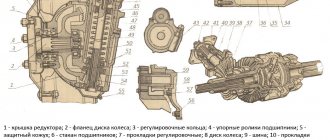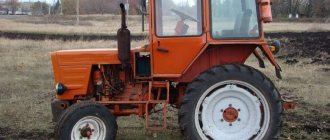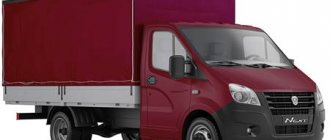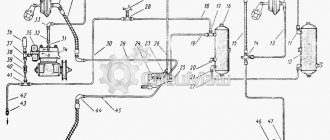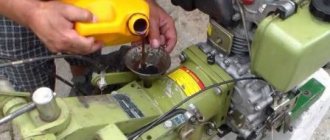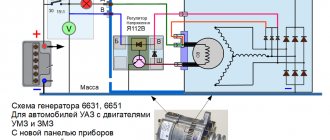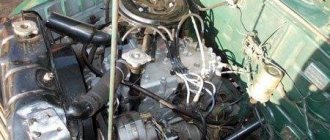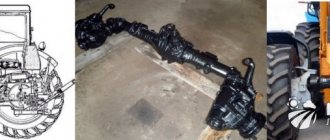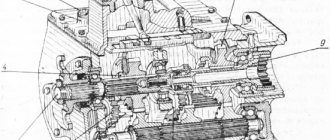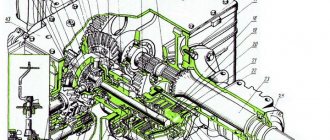The MTZ 80(82) rear axle mechanism, enclosed in a cast iron body, is the most massive part of the tractor transmission. In addition to housing the mechanism, the crankcase serves as the frame of the tractor. The internal cavity is divided by partitions to strengthen the body and accommodate the rotation supports of the mechanisms. Access is through the top hatch, closed with a sheet metal cover. The upper plane of the body is the basis for attaching the tractor cab; brackets for mounting the rear linkage are attached to the rear part of the body; axle shaft sleeves are located on the sides. The planetary gearbox of the rear PTO is located in the rear part of the unit housing.
In tractors MTZ 50(52) and MTZ 80(82), the rear axle assembly is absolutely interchangeable.
Design and principle of operation of the bridge
The bridge has a kinematic diagram with internal final drives. All gearbox parts operate in a common oil bath, are lubricated by splashing, and are combined with the gearbox and intermediate part of the transmission into a single lubrication system. Oil is poured through the plug in the upper gearbox cover to the level of the lower edge of the inspection hole. The total volume of transmission oil filling is 40 liters.
main gear
The gearbox mechanism receives longitudinal rotation from the secondary shaft of the gearbox attached to the front wall of the rear axle housing. The transmission is carried out through a bevel pair of gears with helical teeth. In the bridge design, this gear pair is called the main gear. The gears take the rotation ratio created by the gearbox and convert longitudinal rotation into transverse rotation. The drive gear is placed on the splines of the shank of the secondary shaft of the box and is tightened with a cotter nut. The main drive driven gear is attached to the differential housing with bolts and nuts with locking folding plates.
Differential
The mechanism carries out the function of distributing torque to the drive wheels when the tractor turns, providing different angular speeds of rotation of the drive wheels.
The device is a closed planetary mechanism in a cylindrical housing, consisting of two parts tightened with bolts. Inside the assembly there is a crosspiece, sandwiched by two halves of a housing with four satellites in the form of straight-cut bevel gears rotating on bronze bushings. Thrust steel washers are installed between the satellite body and the axis. The satellites interact with the left and right semi-axial bevel gears, which transmit rotation to the corresponding sides to the drive gears of the final drive of the bridge. Bronze thrust washers are installed between the semi-axial gears and the housing. The gears in the housing cups rotate on tapered roller bearings.
A feature of the differential housing assembly is strict adherence to the position of the connection of the housing parts in accordance with the applied marks. Pay attention when replacing satellites and thrust washers for them. In older designs, the outer thrust plane of the pinion gear and adjacent thrust washer have a flat surface; in newer designs, they have a spherical surface.
Final drives
Part of the mechanism that transmits rotation from the differential directly to the drive axle shafts. The corresponding left and right final drive shafts are inserted into the splines of the differential side gears with their inner ends. Each part is supported by two roller bearings. The drive spur gears of the final drives, which are made integral with the part, are placed on the shafts. Each shaft is supported by two roller bearings. The driven final drive gears are placed directly on the axle shafts and connected through splined bushings. The axle shafts are supported by two ball bearings: the inner one is located in the bore of the crankcase partition, the outer one is in the cast iron casing of the axle shaft. To prevent axial movements, the part is fixed with a locking ring and an axle housing cover with a self-clamping oil seal. Additionally, the outer ends of the final drive drive shafts are connected on the right side to the drums of the right service and parking brake, and on the left side to the drums of the left service brake and differential lock. The locking and holding brake are driven through the tubular cavities of the final drive shafts by additional shafts. A separate mechanism in the lower part of the crankcase from the intermediate shaft of the box extends longitudinally the rear PTO drive shaft with a cam clutch for switching operation modes. The shaft rests on bearings installed in the bores of the transverse partitions of the crankcase.
Features of the MTZ tractor hub
The MTZ wheel hub is a unit connecting the bearing part and the suspension. It is the hub that ensures free rotation of the wheel and transmission of torque.
The main component of the MTZ tractor hub is the bearing. The rotation of the bearing sets the wheel and the brake disc and drum in motion - they rotate relative to the steering knuckle or beam.
The Belarusian MTZ 80 and 82 differ in their drive - the MTZ 80 has rear-wheel drive with a 4x2 wheel arrangement, and the 82nd has all-wheel drive. Accordingly, on the MTZ 80 there is no front axle drive, and rotation from the gearbox is transmitted only to the rear wheels. The front axle serves as a support beam for the semi-frame, on which the steering rods and steering wheels are located. On the drive wheels of MTZ tractors, hubs transmit torque through axle shafts. Their distinctive feature is the presence of special slots into which the output shaft (drive) from the transmission is inserted.
Thus, the MTZ wheel hub performs the following functions:
- transmits torque to the wheel;
- holds the units on the axle shaft;
- allows the tractor wheel to rotate freely;
- holds brake system components;
- attaches the wheel rim.
Repair and adjustment of the rear axle MTZ 80
The rear axle of the Belarus tractor has a fairly reliable design; with proper care, the unit can be operated without major repairs for decades. The main causes of problems are: systematic overloading of the unit with slipping, frequent use of locking under load, lack of sufficient lubrication. The appearance of unacceptable gaps: in the meshing of gears, in the seats in the axes of rotation of shafts and gears when bearings are worn, in splined joints leads to the appearance of unacceptable vibration during the rotation of parts. As a result, runout occurs, leading to coloring of the gear wheel teeth, rapid breaking and wear of the seats, followed by jamming and complete failure of the mechanism. It is recommended to stop operating the tractor if noise, hum or rattle occurs.
When deciding to stop a tractor for repairs, they are usually guided by the principle: “The sooner a problem in the operation of the mechanism is detected and eliminated, the less expensive it will be to repair the unit.”
To gain direct access to the mechanism when diagnosing and repairing the unit, it is necessary to completely dismantle the tractor cabin, fuel tanks, power hydraulic cylinder of the linkage and open the top cover of the axle gearbox and gearbox, as well as drain the oil from the transmission housing. Visual inspection reveals the degree of wear of the mechanism parts. By rotating the gears, inspect the condition of the teeth; using a mandrel (mount), check for the presence of shackles on the axles and rotation supports, in the seats of the mechanism parts, and in the meshing of gears and splined joints. Based on the fact of detected problems, a decision is made to dismantle parts or components of the mechanism for final detailed troubleshooting and subsequent replacement of parts.
MTZ front and rear hubs: size, numbers of bearings and seals, how to remove and disassemble
All wheels of MTZ tractors have hubs. This design ensures high maintainability of the suspension and allows you to replace individual parts without disassembling the entire assembly. The MTZ wheel hub is necessary to connect the bearing to the suspension. Due to this, free rotation of the tractor wheels is achieved.
We will talk further in the article about the structure and size of the MTZ front and rear wheel hubs, what is the difference between the old and new parts, how to remove, disassemble and make adjustments.
Front axle axle malfunctions
Despite the fact that components of this type are made of strong metal, breakdowns sometimes occur during operation. Do not forget that the MTZ axle shafts of the rear axle take on the weight of the rear of the car.
They are subject to additional bending loads. If components are not replaced in time, the performance of the equipment will noticeably deteriorate. Most often, problems are identified in the front axle shafts of the tractor in the form of:
- Wear of gear teeth leading to destruction;
- Wear of the seat for bearings of the MTZ 82 axle shaft;
- Broken part;
- Appearance of cracks.
With such malfunctions, a specific noise appears, and metal particles can be found in the oil.
Sometimes it can even get to the point where the wheels jam. In order to diagnose and monitor the condition of components, as well as to replace axle shafts, the bridge is disassembled in accordance with the manufacturer’s instructions. To press the part out of the housing and remove the bearings, a special tool is required.
Damage to the axle shafts of the MTZ rear axle
In the rear axles, the splines are often damaged, the locking groove for the hub and the rack for the adjusting worm wear out. Parts may become deformed and sometimes cracks may appear. In such cases, play and vibrations of the wheels are noticeable, it is impossible to adjust the track or reliably install the hub.
Diagnostics and repairs require removing the wheel and pressing out the axle shaft with a special puller. For replacement, axle shafts recommended by the equipment manufacturer are used. The axle shafts can be replaced one at a time or in pairs.
The second option is more preferable due to the equal wear of parts on both sides. At the same time as the axle shaft, it makes sense to replace the bearing using new seals, as well as a cotter pin to secure the hub.
Do not forget to do timely maintenance of the MTZ rear axle and axle shafts. Remember that if even a small crack is detected, it is best to replace the components with new ones.
On our website you will find a large catalog of MTZ spare parts. In the store it is easy to buy bearings, axle shafts, axles, cardan shafts, shock absorbers, gears and much more for a modern tractor in Rostov. It’s easy to check the availability of goods and the cost of MTZ parts by calling +.
To remove the left brake, see: From levers 16 and 12, force is transmitted through spherical washers 11 and bolts 8 to forks 6, which are pivotally connected to pressure plates using rods 18 and pins.
Pressing out the bearing from the rear axle housing: 1 - bearing; 2 — rear axle housing; 3 - inertial puller. The pedals and disks return to their original, released position under the action of the tension springs 15 and the springs 3 of the pressure disks. Access to the left sleeve is provided by removing the hydraulic accumulator and the left cabin bracket, and access to the right one is by removing the right cabin bracket complete with brake valve and pneumatic adapter. This was done in order to provide the necessary agrotechnical clearance for inter-row cultivation of tall row crops. Pressing the bearing cup: 1 - bearing cup; 2 - technological bolt. Components are made from steel grade 20ХН3А or analogues. The main causes of malfunctions of the rear axles MTZ, 80 If, when the tractor is moving, it pulls to the side when braking and the brake pedal travel increases, this indicates wear on the disc linings and a violation of the adjustment of the brake control mechanism. Brakes are used to slow down the speed of the tractor, bring it to a complete stop, and also to hold the stopped tractor stationary. Noises and knocks in the axle sleeves of the drive wheels indicate wear or destruction of the bearings. We guarantee the best quality of parts, affordable prices and fast delivery to any city in the country. The main causes of malfunctions of the rear axles MTZ, 80 If, when the tractor is moving, it pulls to the side when braking and the brake pedal travel increases, this indicates wear on the disc linings and a violation of the adjustment of the brake control mechanism. Repair of the front axle MTZ-82.
Engine Nissan VR38DETT 3.8 l
Where to buy MTZ 80 axle shafts? If the thickness of the tapes is less than 2.5 mm, they are replaced with new ones. However, their units can be used to complete the same bridges. When acting on the rod, the handle of which is located at the right wall of the cabin, the latch 17 rotates and engages with a stop welded to the lever 16 of the right pedal. Removing the left cab bracket. This was done in order to provide the necessary agrotechnical clearance for inter-row cultivation of tall row crops. The independent drive is located in the clutch housing. We guarantee the best quality of parts, affordable prices and fast delivery to any city in the country. If it is more or less, then the pedal stroke is adjusted as follows. The clutch is hydraulically driven from the tractor's power steering. If the thickness of the tapes is less than 2.5 mm, they are replaced with new ones. Replacing the bearing in the axle shaft of the MTZ 892 tractor, first day, beginning
Design and size of the MTZ rear hub
The MTZ rear hub is mounted on the protruding end of the rear axle final drive axle shaft. Fastening is carried out using a key, a liner and four bolts. The liner has an adjusting screw - it engages with a toothed rack cut into the axle shaft. By rotating the rear hub screw, you can move it relative to the axle shaft. This way the rear track width is adjusted.
Bolts are pressed into the rear wheel hub flanges. They are used to fix the wheel rim. The disc holes have raised conical chamfers that prevent arbitrary loosening of the nuts.
When installing the MTZ rear wheel hub, it is extremely important to ensure that the nuts are evenly tightened. You need to make sure that their chamfers fit snugly into the cone-shaped holes in the rims. If the hub nuts are not tightened sufficiently, cracks will appear in the disc holes and the threads may become damaged. It is necessary to control the tightening both when replacing a wheel rim and during operation of the tractor: it is recommended to inspect the MTZ hub nuts every 240 operating hours.
The rear wheel hub, as in the case of the front wheel, is protected from dirt by a protective visor welded to the axle shaft, which is located with a small gap in relation to the hub.
Size and number of the rear hub MTZ 80 and 82
| Catalog number (catalog group – Chassis) | 627786 Additional numbers: 50-3104010-A1, 70-3104010 |
| length, mm | 160 |
| width, mm | 300 |
| height, mm | 300 |
| weight, kg | 23,4 |
The difference between the hubs of old and new MTZ tractors
Previously, Belarusians were equipped with smaller hubs with small bearings. In the early 80s they were modernized and made larger. In addition, the MTZ hub bearings of the new model were unified with the YuMZ hub bearings, so that they became interchangeable. The difference between the MTZ and YuMZ hubs is only in the width of the flange: on Belarusian tractors it is thinner and there is no grease fitting.
New MTZ wheel hubs are reinforced.
| Old style hubs | New model hubs |
| smaller, with small bearings | more, reinforced |
| distance from the protrusion for the cover fastening bolts is 1.5-2 cm | the distance from the protrusion for the cover fastening bolts to the disk is 0.5-1 cm |
| oil seal 65x90 | oil seal 80x105 |
Activities
The differential locking mechanism is a hydraulically driven friction clutch mounted on the shaft of the left final drive gear. Make sure that the glass and body are securely fixed and remove the glass assembly. A preload of no more than 0.1 mm is allowed with the force applied to the outer end of the teeth of the driven gear of the main gear to rotate the differential in the bearings. Then release the lock nut 3, screw the adjusting bolt 2 all the way into the shift roller lever 5 and the locking bolt 4 into the mechanism spring cup reinforcement, then hold the cup with your hand and carefully unscrew the adjusting bolt 2. When you press the pedal, the rods are 14 cm. Pressing the bearing cup: 1 - bearing cup; 2 - technological bolt. MTZ 82 bridge repair. Make sure that the glass and body are securely fixed and remove the glass assembly. Axle shafts are replaced when the bearing seat is worn to a size of less than 84.95 mm, or when the keyway is worn. The cavity of each brake is protected from oil entering from the rear axle housing by two self-clamping 32 cm cuffs.
Engine VAZ 11183
A press or clamp is also used for assembly. We guarantee the best quality of parts, affordable prices and fast delivery to any city in the country.
Noises and knocks in the axle sleeves of the drive wheels indicate wear or destruction of the bearings. A preload of no more than 0.1 mm is allowed when the force is applied to the outer end of the teeth of the driven gear of the main gear to rotate the differential in the bearings,
Then release the lock nut 3, screw the adjusting bolt 2 all the way into the lever 5 of the shift roller and the locking bolt 4 into the spring cup of the boost mechanism, then hold the cup with your hand and carefully unscrew the adjusting bolt 2. If it is larger or smaller, then the pedal stroke is adjusted as follows . In case of breakthroughs, the gasket is replaced. The pedals and disks return to their original, released position under the action of the tension springs 15 and the springs 3 of the pressure disks. MTZ PUSASS MAIŅA..(Replacement MTZ axle shaft)
Catalogs, spare parts, bearings, belts and more...
When pressing the pedals the rods are 14 cm.
To increase the lateral clearance in the teeth, these spacers are moved from the left side to the right.
Its locking is activated automatically when the MTZ front axle is turned on. After this, worn parts are replaced. Thus, with braking of one inner wheel, the turning radius of the tractor in the middle of the track of the outer front wheel is 4 m, and without braking - 5 m.
This test also determines whether the left and right brakes operate in sync. Therefore, in order not to disturb its engagement when adjusting the bearings, it is necessary to reduce the thickness of the adjusting shims 38 of only the left side.
Buying a half shaft
The planetary gear carrier is replaced when the surfaces under the satellite axles are worn to a size of more than 20.2 mm and the surfaces under the brake band to a size of less than .0 mm. Pressing the bearing into the axle shaft sleeve: 1 - bearing; 2 — axle sleeve; 3 - puller. Defective parts found are replaced. The housings of the axle shafts of the wheel reducers are connected to the RVD hoses of the MTZ front axle telescopically, which allows for stepless adjustment of the track of the front drive wheels within the same limits as the rear ones.
Rods 18 transmit force to the pressure disks, forcing the disks to rotate relative to each other, which causes the balls to roll along the inclined surfaces of the disk socket and decompress the disks. The independent drive is located in the clutch housing. Features of axle shafts in the rear axle The rear axle shaft of the MTZ 82 has splined connections on the inner side and places for installing the wheel hub on the outer side. The axle shafts are sealed with a self-clamping cuff 24 installed in the cover. They are installed on the shafts of the final drive gears on the left and right sides and are covered with 33 cm casings.
187 advertisements found
Access to the left sleeve is provided by removing the hydraulic accumulator and the left cabin bracket, and access to the right one is by removing the right cabin bracket complete with brake valve and pneumatic adapter. Pressing the bearing into the axle shaft sleeve: 1 - bearing; 2 — axle sleeve; 3 - puller.
The pedals and disks return to their original, released position under the action of the tension springs 15 and the springs 3 of the pressure disks. The thickness of the gaskets is 0.2 and 0.5 mm. Continuing rotation of the shaft shank when the rear PTO is turned off or its uneven rotation indicates a violation of the adjustment of the brake bands and their wear. When this cannot be achieved through adjustments, the brakes are removed and repaired. Therefore, in order not to disturb its engagement when adjusting the bearings, it is necessary to reduce the thickness of the adjusting shims 38 of only the left side. Repair of MTZ 82 started from the rear axle, reached the gaps
Design and size of the MTZ front hub
The MTZ front wheel hub is made in the form of a cast iron part with a flange and a double bore for bearings. Bolts are pressed into the flange to secure the wheel rim.
The front hub rotates on 2 bearings - they are conical roller bearings. The inner race of the bearing is fixed on the axle shaft, the outer race is pressed into the hub bores.
The front wheel hub bearings are tightened with a nut that screws onto the threaded end of the axle shaft. There is a spacer washer between the bearing and the locking nut. To prevent it from rotating around the axle shaft (to prevent the nut from being unscrewed), the washer fits into the groove of the axle shaft with a mustache.
On the outside, the front wheel hub is covered with a stamped cap. A self-tightening cuff is inserted into the bore from the inside. To provide a stronger seal, a protective visor is attached to the axle shaft. It covers the tractor's front axle hub with a small gap.
On MTZ 82 and 102 tractors, the front wheels are fastened using bolts to brackets that are welded to the rim.
Size and number of bearings of the front hub MTZ 80
New reinforced hub
| Installation location | Catalog number | Size |
| internal support | 7609A 32309 | roller tapered angular contact bearing: D − 100 d − 45 B – 38.25 |
| external support | 7608A1 32308 | roller tapered angular contact bearing: D − 90 d − 40 B – 35.25 |
Front wheel hub MTZ old model
| Installation location | Catalog number | Size |
| internal support | 7608A 32308 | roller tapered angular contact bearing: D − 90 d − 40 B – 35.25 |
| external support | 7606A 32306 | roller tapered angular contact bearing: D − 72 d − 30 B – 30 |
| Bridge axle axis | 8208 51208 | thrust ball D−68 d − 40 B–19 |
